| Full name | Bronte Surf Life Saving Club |
|---|---|
| Founded | 1903 |
| Members | 500 senior, 250 junior |
The club was founded in 1903 and the movement has since spread to other parts of New South Wales and the rest of the country. The club rests on indigenous land and whilst there is no clear evidence for the name or names of the Eora people who lived in what is now the Waverley area, most sources agree on the Cadigal, but some sources name the Biddigal and Birrabirragal bands as well. [1]
After swimming became more acceptable amongst society in the very late 1800s, the rate of drownings increased significantly at Bronte beach and other beaches across NSW. As such, it became obvious that there was a need for some system to protect people who had ventured into the surf. [2] Although there were no surf clubs there were swimming clubs up and down the east coast of Australia with groups of individuals who became the unofficial surf lifesavers. William Henry a renowned English and European swimming champion in the 1880s and 90s approached the Royal Humane Society to develop a lifesaving programme. [3] This resulted in the formation of the Swimmers Life Saving Society, later changed to Life Saving Society. [4]
In 1883, Henry who was the secretary of the lifesaving society gave a copy of the handbook, which outlined rescue and resuscitation methods, to Frank Lloyd, who was the caretaker at Bronte Baths and the secretary of the NSW Amateur Swimming association. [5] Lloyd gave the handbook to John Bond, a Warrant officer in Sydney's Medical Corps, and Captain Arthur Holmes. On 31 July 1894 Bond and Holmes were instrumental in the establishment of the lifesaving society in Australia in the Sydney suburb of Waverley. Throughout 1894 both Bond and Holmes put on three surf lifesaving demonstrations in which around eighteen men were versed in various lifesaving methods. [6] These men would go on to be the first in Australia to receive the Bronze Medallion. [7]
Although surf bathing was becoming more acceptable in society it was still illegal to swim on the beach in daylight hours. In the early 1900s authorities were coming under immense pressure to legalise surf bathing. In September 1902 English born newspaper journalist, William Gocher, advertised that he was going to defy the authorities and swim at noon on three consecutive Sundays at Manly beach. Gocher's protest worked and started the Australian tradition of "going to the beach". [8]
Now that bathing at all times of the day was legalised, drownings increased significantly. On boxing day 1902 a swimmer, William Fox, was swept out to sea at Bronte's south end [9] Despite the efforts of locals, Fox ended up drowning. Fox's death shook the Bronte community resulting in Waverley council purchasing lifesaving equipment and legitimising the unofficial surf lifesavers at Bronte Beach. This led to the creation of the Bronte Surf Bathers Lifesaving Club (later changed to the Bronte Surf lifesaving Club) in 1903. [10]
Women were unable to join BSLSC and other lifesaving clubs around NSW as it was believed that they were not strong enough to operate the heavy equipment or manoeuvre themselves through the surf. [11] Despite this two women, Annie Brown and Fanny Durack, established the Eastern Suburbs Ladies Amateur swimming club in 1916 (ESLASC). [12] However, the group was closed down during World War Two and was re-established as the Bronte Ladies Amateur Swimming club (BLASC) in 1946. [13] However, the issue of women becoming fully fledged members of the surf club continued to be raised and came to its head in 1977 with Lindsay Donnan. [14] Donnan's brothers were members of BSLSC and she wanted to become an active member. The BSLC called a general meeting to discuss her application to become a member. A large number of people attended the meeting, and many had strong opinions as to why women should not be allowed to participate in surf lifesaving. [15] Donnan's application was denied, and she later stated that "for me, it was sad and very hurtful. People were rude. I was shunned and I felt isolated, as if I was not welcome at the beach". [16] It wasn't until 1980 with the passing of the Anti-discrimination Act that women were able to become members of surf lifesaving clubs across Australia.[ citation needed ]
In the early days of surf lifesaving there were no flags to signal safe places to swim and there was no organised patrol system in place. [17] If there was any trouble on the beach and alarm bell would ring, signalling all members on the beach to move to where the problem was occurring and to help. A lookout tower was also built in which a man would climb and wave flags around to signal to other surf lifesavers on the beach that someone was in trouble. [18] Later ropes that were attached to wooden stakes at various points along the beach were thrown into the water when someone was in trouble. However, the wooden stakes were often quite flimsy leading to awkward rescues. This led to the surf life reel which was invented at Bondi in 1906 by Lyster Ormsby who made a model of his invention from a cotton reel and two hairpins. [19] According to Vesper, "the surf lifesaving reel, which is still used today in competition, was the basic surf lifesaving aid for many years…it wasn’t until the 1970s that it was phased out". [20]
In 1906 the first Australian purpose-built surfboat was invented by Bronte Surf lifesaving club member Walter Biddell. [21] It was a ‘catamaran type boat’ with kapok stuffed torpedo shaped tubes made of wood, tin and canvas. [22] Biddell later designed the ‘Albatross’ surf boat. Whilst the surf boats were initially used in rescues, today they are purely used for competition purposes. In the early days, apart from the surf boats, the reel and belt, surf lifesavers began experimenting with a variety of devices to help with the job. Surfboards and surf skis were adapted from being sports of pleasure to being used in rescues. Surfboards today are instrumental tools in conducting successful and safe rescues.
Before the advent of Shark nets in 1937, Bronte along with other beaches in Sydney's east had frequent shark sightings. In the early hours of Wednesday 13 February 1924, a 30-year-old women Nita Derritt, was badly attacked and mauled by 10 ft (3.0 m) shark at Bronte Beach. [23] Bronte lifesavers Eric Bennett and Jim Brown ran bravely into the water and rescued Nita. [24] Her leg had been bitten off below the knee and her right foot had been torn off. [25] Nita Derritt survived the attack with two amputated legs.
On Saturday 1 February 2020, off duty lifeguards at Bronte Surf lifesaving club performed a mass rescue at Bronte Beach. According to Surf lifesaving NSW, James McLennan, who is Club Captain at Bronte Surf Club, and his wife Kirsty were relaxing at their home at Bronte Beach when they noticed a large group of people caught in a rip at Bronte. [26] After James reached the swimmers caught in the rip, he realised there were actually nine people in the group – not the six he first thought. [27] According to James, "One guy was in a particularly bad way. He had ingested a lot of water and was drifting in and out of consciousness. He was frothing at the mouth and I had to clear his airway several times while I was paddling him back to the beach on my board," James said. [28]
In the early hours 20 April 1972, a devastating fire broke out which destroyed the clubhouse at Bronte. An electrical fault was suspected to have caused the fire; however, some people did not believe that it was an electrical fire. Others believe that the fire was long overdue: "There was no chance of putting it out. It was going too well. The fire spread through the roof and within minutes it was a blazing fire. There has been a lot of conjecture whether the fire was a godsend or a tragedy. It was past its used by date". [29]
Following the Cronulla riots in 2005 Surf Lifesaving Australia alongside Bronte Surf lifesaving club formed an alliance with the Sutherland Shire Council in southern Sydney and the (then) Department of Immigration and Multicultural Affairs to establish the 'On the same wave' program. [30] According to Surf lifesaving Australia the program "aims to increase Surf Life Saving's openness and responsiveness to cultural diversity and increase diversity within clubs". [31]
On 31 May 1942 three Japanese submarines came into Sydney harbour and sank the Australian depot ship Kuttabul, killing 21 sailors. [32] Soon after on 8 June Bondi, Dover heights, Bellevue Hill and Paddington were hit by shells fired by a Japanese Submarine. [33] Following the attacks on Sydney shores authorities fortified Bronte beach with barbed wire. To reach the water at Bronte, beachgoers had to zigzag back and forth between rows of barbed wire stretched along the sand. [34] Searchlights were positioned on the hill at the northern end and machine guns were placed on the promenade in front of the surf club and in front of the baths. [35]
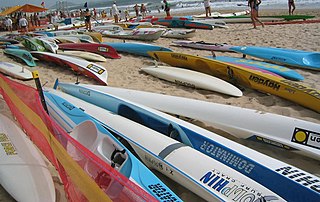
Surf lifesaving is a multifaceted social movement that comprises key aspects of voluntary lifeguard services and competitive surf sport. Originating in early 20th century Australia, the movement has expanded globally to other countries, including New Zealand, Ireland, South Africa, and the United Kingdom. Surf lifesavers in Australia are colloquially known as "Clubbies".
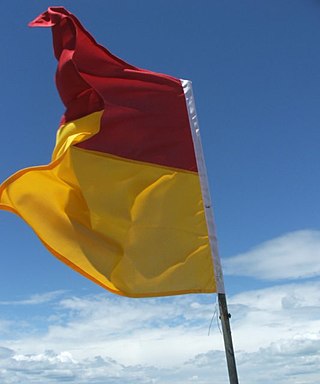
A lifeguard is a rescuer who supervises the safety and rescue of swimmers, surfers, and other water sports participants such as in a swimming pool, water park, beach, spa, river and lake. Lifeguards are trained in swimming and CPR/AED first aid, certified in water rescue using a variety of aids and equipment depending on requirements of their particular venue. In some areas, lifeguards are part of the emergency services system to incidents and in some communities, lifeguards may function as the primary EMS provider.

Bondi Beach is a popular beach and the name of the surrounding suburb in Sydney, New South Wales, Australia. Bondi Beach is located 7 kilometres east of the Sydney central business district, in the local government area of Waverley Council, in the Eastern Suburbs. It has a population of 11,656 residents. Its postcode is 2026. Bondi, North Bondi, and Bondi Junction are neighboring suburbs. Bondi Beach is one of the most visited tourist sites in Australia sparking two hit TV series Bondi Rescue and Bondi Vet.
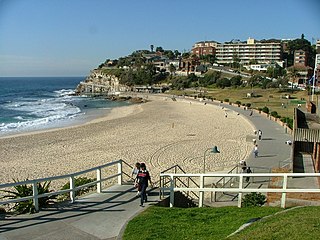
Bronte is a beachside Eastern Suburb of Sydney, in the state of New South Wales, Australia. Bronte Beach is located 7 kilometres east of the Sydney central business district, in the Waverley Council local government area of the Eastern Suburbs.
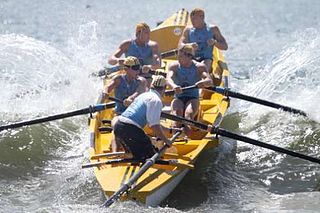
A surfboat is an oar-driven boat designed to enter the ocean from the beach in heavy surf or severe waves. It is often used in lifesaving or rescue missions where the most expedient access to victims is directly from the beach.

Clovelly is a small beach-side suburb in Sydney's Eastern Suburbs, in the state of New South Wales, Australia. Clovelly is located 8 kilometres south-east of the Sydney central business district, in the local government area of the City of Randwick, within the Federal Division of Wentworth.

Nippers are young surf lifesavers, usually aged between 5 and 14 years old, in clubs across Australia, New Zealand and South Africa. Unlike senior surf lifesavers, the majority of them do not patrol the beaches. The focus for Nippers tends to be on fun, and surf awareness.

Surf Life Saving Clubs are volunteer institutions at Australia's beaches. The clubs conduct surf lifesaving services on weekends and public holidays, and in the 2014-2015 season they saved 12,690 people. They also host many beach sport activities, such as Nippers, surf carnivals and other competitions. The SLSCs are responsible for the education of Lifesavers including operation of Inflatable Rescue Boats (IRBs) and maintaining radio communication with other beaches and air rescue resources.
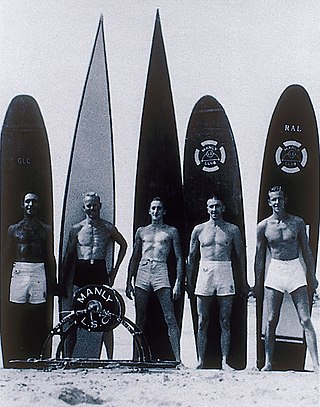
The Manly Life Saving Club is one of Australia's oldest Surf Life Saving Clubs, founded in 1911; located in the Sydney suburb of Manly, in the Northern Beaches Council in New South Wales.

Piha Surf Life Saving Club is a surf lifesaving club for the southern section of Piha, on the west coast of Auckland, New Zealand, some 45 km from the Auckland City centre. The patrol was featured in the TVNZ reality show Piha Rescue.

The International Life Saving Federation (ILS) is an organisation for drowning prevention, water safety, lifesaving and lifesaving sports.

The Westpac Lifesaver Rescue Helicopter Service is a helicopter surf lifesaving service that operates in Australia.

The Coogee Surf Life Saving Club is a foundation member of the surf lifesaving movement in Australia. It was founded in 1907 by a group of concerned locals and has a proud history of no lives being lost whilst its members have patrolled. Coogee SLSC celebrated its 100-year anniversary in 2007, the Year of the Lifesaver.

Surf Life Saving Australia (SLSA) is an Australian not-for-profit community organisation that promotes water safety and provides surf rescue services.

Lifesaving is the act involving rescue, resuscitation and first aid. It often refers to water safety and aquatic rescue; however, it could include ice rescue, flood and river rescue, swimming pool rescue and other emergency medical services. Lifesaving also refers to sport where lifesavers compete based on skills, speed and teamwork. Lifesaving activities specialized in oceanic environment is called surf lifesaving or coastal lifesaving.
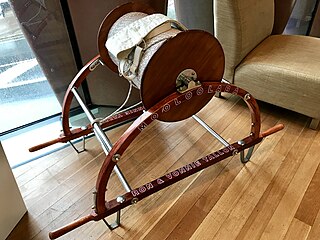
The surf life saving reel was a beach life saving apparatus from Australia.

Bronte Beach is a small but popular recreational beach in the Eastern Suburbs of Sydney, Australia. It is a division of the LGA of Waverley Council. Bronte Beach is 2 kilometres south of Bondi Beach and north of the much larger Coogee Beach.
The Bondi Surf Bathers' Life Saving Club is Australia's oldest Surf Life Saving Club, founded in 1907. The club was officially established on 21 February 1907 at the Royal Hotel in Bondi Beach, Sydney, New South Wales. The clubs aim is to ensure "No Lives Lost" at Bondi Beach and is a volunteer organisation that patrols Bondi Beach from October to April every year.
The Freshwater Surf Life Saving Club, established in 1908, is located at Freshwater Beach in Australia. It has become a large volunteer organization with strong community bonds. The club was founded by a push from government to foster safer beach practices. It is a part of Surf Life Saving Australia, a not-for-profit organization committed to keeping the beach safe for patrons and providing beach rescue services. A visit to the club from United States' surfer, Duke Kahanamoku, in 1914 helped initiate the sport of surfing in Australia.

Lifesaving is an official discipline of the World Games, the Games with all the sports, recognized by the IOC but not yet in the Olympic program.